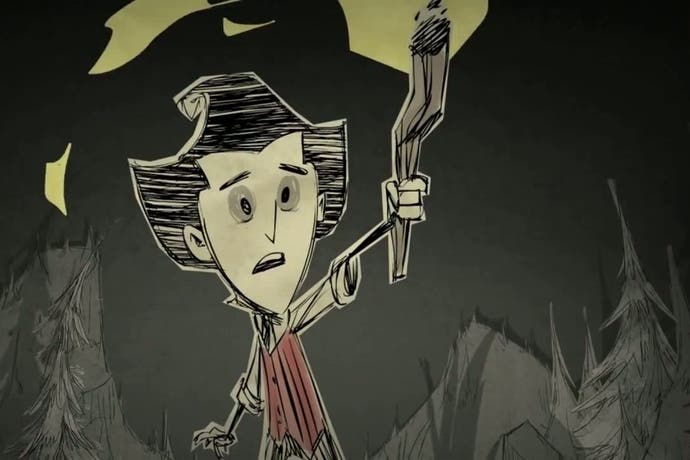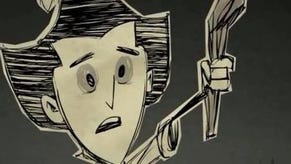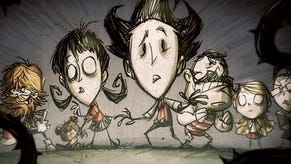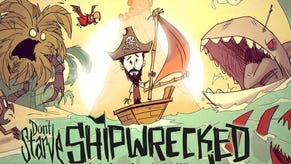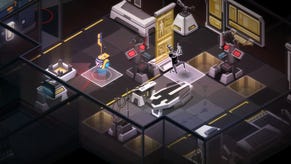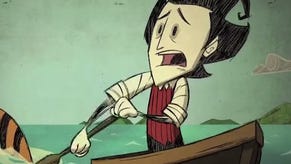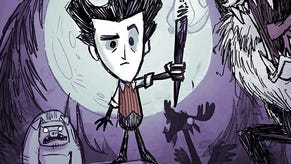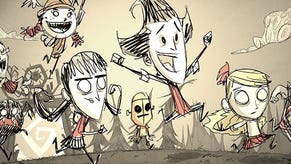Don't Starve review
Food for fort.
Klei Entertainment's survival sim is a tricky one. That title seems so helpful, pretty much doubling as a minimalist player's guide, but it misleads you, dear reader. It makes you start the game thinking that your main concern will be acquiring ample food reserves, but that's not the case. Not really.
I have died many, many times in Don't Starve, and not once was my cause of death mere starvation. I came close once or twice, but every time my demise came from the local wildlife. My first game ended almost immediately after I was hacked to death by territorial Pig Men. Next, I was pecked and kicked to death by Tallbirds. A later game came to an abrupt and ignoble halt when a herd of Beefalo took it in turns to trample me into the dirt. In my most shameful moment, I was done in by frogs. ****ing frogs.
Thing is, responsibility for each death rested undeniably with me. Don't Starve is a game that you prod with sticks, gingerly testing each new thing you discover to see what is dangerous. Clue: pretty much everything is. And yet I still wandered around its ominous yet charming randomly generated maps, blundering into the paths of creatures and then goading them into deadly action like an inept Bear Grylls. It was my idiotic notion that I could swipe a Tallbird egg for me tea. It was me who reckoned I could kill a Beefalo with my feeble flint axe and be away with its meat before its family noticed. It was my hubris that led me to take on a gang of frogs - ****ing frogs - confident that I could do more damage to them, en masse, than they could do to me with their stupid sticky tongues and fat rubbery thighs. Wrong, wrong, wrong.
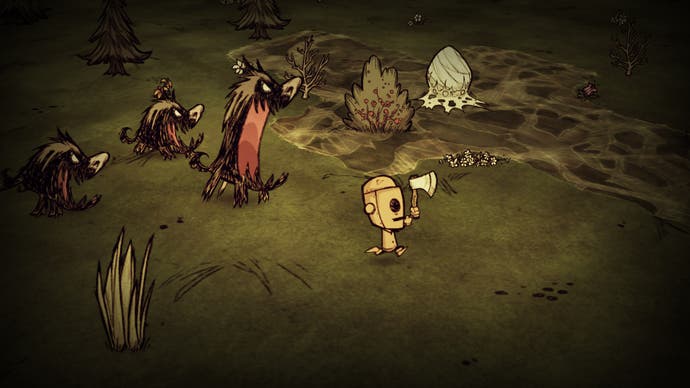
That feeling - knowing something is a terrible mistake, yet still feeling compelled to try it anyway - persists throughout Don't Starve and is one of its best features, since it proves that survival really is up to you. Not once has it felt like the game has treated me unfairly. It was always my fault. Don't Be An Idiot would be better, if less marketable, title.
As with many of the modern crop of survival games, Don't Starve grows from a Minecraft seed, but it flowers into something very different. Cast as a gentleman scientist, banished to a mysterious and hostile hinterland after striking a deal with a demon for forbidden knowledge, you'll start by gathering twigs, grass and bits of flint from the ground. Very quickly you're able to craft an axe, which allows you to fell trees and harvest wood, which lets you craft a pickaxe, enabling you to start mining rock. It's a familiar progression, and one that eases you in relatively gently.
Don't Starve is much more ruthless and bleak than Mojang's procedural worlds, however. In Minecraft, the world is your resource, and you get to flex your creative muscles in reshaping it. Don't Starve is a world of washed-out colour that feels like you're watching the action through a veil of black gauze. You get what you're given - and what you're given often isn't very much.
At first you'll sustain yourself with berries and seeds, maybe a carrot swiped before a rabbit - one of the few creatures that won't murder you - can scoff it. When night falls - its arrival heralded by a ticking, colour-coded countdown clock in the corner of the screen - you'd best be sure you've got the material needed to build a fire. Darkness in this game is almost instantly fatal, as you're torn to shreds by unseen monsters in the impenetrable gloom.
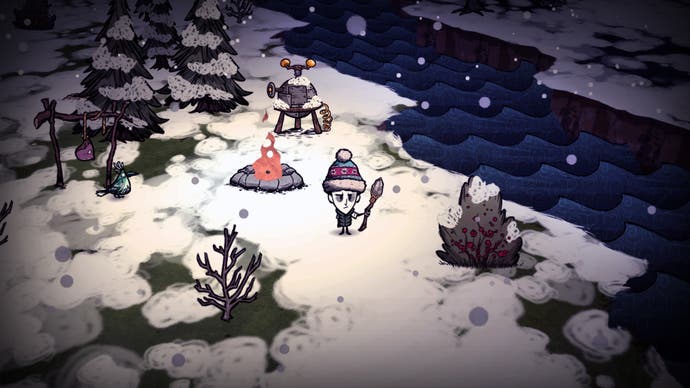
Over time, and over many failed attempts to eke out a living on this inhospitable terrain of scrubland and sinister forest, you start to work out what to do, and it's here that Don't Starve is at its most rewarding. There's no hand-holding at all, and it's up to you to work out how this bizarre world works. Sometimes that means hitting a Beefalo with an axe, but more often it means picking some strange fruit, flower or vegetable and daring yourself to eat it. I made the mistake of gorging on the squirming, screaming sentient mandrake root, which led me to black out and wake up with swimming vision. Not long after that, I began to catch glimpses of phantom creatures moving around me, and hear terrifying droning noises as the world wobbled and swirled at the margins. Still, at least it filled me up.
I still have no idea what that meant, but I'm OK with that. I know I could hit Google and discover everything I need to know about this topsy-turvy land, but it's a testament to Don't Starve's bespoke interior narratives that I feel like I'd be cheating myself out of some wonderful discoveries if I did that. Instead I'll keep building "science machines" - the constructions that let you create prototype items which can then be added to your crafting menu - and prodding the world to see what happens. Even if "what happens" is that I get killed by frogs.
Don't Starve's suck-it-and-see progress is made even more enticing thanks to the delightful art style - one part Tim Burton whimsy to one part Edward Gorey creepiness - and some superb sound design. Taking an axe to a tree results in a satisfying echoing THWOCK, fires crackle and hiss, while dialogue windows and text prompts arrive with an off-kilter parp or honk. It all adds up to a chintzy gothic aesthetic that is incredibly appealing.
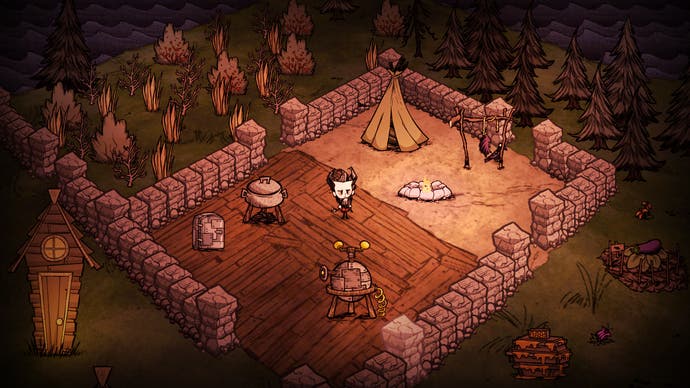
The PC control scheme has been thoughtfully adapted to the joypad, with the right stick navigating your always-visible inventory and crafting menus, the face buttons carrying out in-world actions and the d-pad used for inspecting, dropping or using the items in your backpack. It seems like a fumble when written down, but in practice it's very intuitive. It also looks gorgeous when played on the PlayStation 4, crisp and smooth and filled with detail. The major downside is that both text and icons are now vanishingly small, to the extent that playing it from a sofa across the room is a recipe for squinting. I found myself having to sit on a cushion in front of the TV to work out what some of the crafting recipes required.
As with all survival games, Don't Starve eventually hits a plateau where you need to invest serious time and effort or else move on to something else. Here, that moment comes once you've researched how to start building walls, planting crops and have established a rudimentary home in this alien land. The more impressive your homestead, the greater the fear of making a terrible mistake and losing it all to the game's unforgiving permadeath. You can get at least one stay of execution by finding and activating a "touch stone", but for the most part, once you die, that's it. The world and everything you built is gone forever.
That shift from exploration to sustainability can make some of the game's core systems - the daily tromping around, gathering material - into a chore. If you're not fully invested by that point, this may not be the game for you.
And that's fine, because Don't Starve really isn't a game for everybody. It's never stronger than in its opening hours, and if it never quite recaptures that first heady whiff of discovery, it at least keeps you on the edge of your seat thanks to its punishing design, the stakes rising in tandem with your achievements. So while the game starts to falter in the long term, fans of hardcore roguelike adventures and uncompromising survival gameplay alike won't go hungry.
